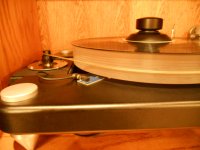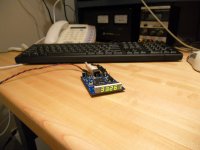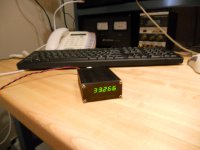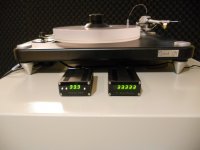The motors fight each other,but this is their problem for now.The pulleys are the same under the micrometer.Outer diameter is just to get more inertia and how I said before,just using one heavy pulley you get better results.For control the speed I use my watch.
Only thing you would have to worry about, is if one motor decides to get hot, hotter than the others. Other than that I doubt there is little fight between them. Not sure why you decided to place them all in series, I would have preferred to have them all in parallel. Each motor should be provided with the manufacturers recommended voltage, not more not less.
For control the speed I use my watch.
I would use a test record with test tones. A 1KHz test tone could easily be measured with a frequency meter. Using a frequency meter would be even more accurate than viewing a stroboscope pattern.
measuring rotational speed
I use a cheap digital tachometer. The great thing is that the measured speed is +/- 0.005 RPM (x:= 33.33, using error analysis, 1/2 of the smallest placeholder value possible is used as sigma, σ, provides 0.0005/x=σ(x).
The result is then:
.005/33.33≊0.00015 or 0.015% error in accuracy.
I usually get a reading of 33.34 on my table , resulting in an error of δ(x):=.01, which results in an error twice as large or 0.030%.
These errors can then be added to obtain the total error, σ(x)+ δ(x)= 0.045%
At 1000Hz, that error calculates to (0.01/1%)*(.045%)*(1000Hz) = 0.45Hz. Close enough for me .
.
Now if you have a "smart phone" there may be an app that can provide you with an accurate frequency measurement. If there is something like that and the microphone is accurate, then it could also take into consideration of the frequency error in your loudspeakers at 1000Hz.
If using a stopwatch, then marking your platter and counting 100 rotations could give you enough accuracy, as long as your reaction time has been calculated as well.
The motors may not be "fighting" much, and is of small consequence as far as I am concerned. I suppose a thermocouple could be used to measure each motor's temperature, but the small variances that may exist are quite likely due to manufacturing tolerances and difficult to overcome.
I'm assuming FZ:= Frank Zappa.
I use a cheap digital tachometer. The great thing is that the measured speed is +/- 0.005 RPM (x:= 33.33, using error analysis, 1/2 of the smallest placeholder value possible is used as sigma, σ, provides 0.0005/x=σ(x).
The result is then:
.005/33.33≊0.00015 or 0.015% error in accuracy.
I usually get a reading of 33.34 on my table , resulting in an error of δ(x):=.01, which results in an error twice as large or 0.030%.
These errors can then be added to obtain the total error, σ(x)+ δ(x)= 0.045%
At 1000Hz, that error calculates to (0.01/1%)*(.045%)*(1000Hz) = 0.45Hz. Close enough for me
Now if you have a "smart phone" there may be an app that can provide you with an accurate frequency measurement. If there is something like that and the microphone is accurate, then it could also take into consideration of the frequency error in your loudspeakers at 1000Hz.
If using a stopwatch, then marking your platter and counting 100 rotations could give you enough accuracy, as long as your reaction time has been calculated as well.
The motors may not be "fighting" much, and is of small consequence as far as I am concerned. I suppose a thermocouple could be used to measure each motor's temperature, but the small variances that may exist are quite likely due to manufacturing tolerances and difficult to overcome.
I'm assuming FZ:= Frank Zappa.
Last edited:
The motors are AC synchronous, so theoretically they should all rotate at the exactly the same speed. The only problem I see is if the sheave(s) that drives the belt are different diameters. But they can be measured for exactness.
No degree of 'exactness' is sufficient because if it was, there would be no need for servo'd motors.
In the case of multiple motors on a turntable, the rubber belt will take up the 'slack' by stretching and shrinking slightly. The largest pulley motor will be doing more work as it's forcing the other 2 a little bit faster by changing the belt tension.
G²
AC
The AC siynchronous motors have 24 pols and they tend to be different between them just in this 24 pols and not in one turn,because their speed 250 rpm is determined with frequency of 50Hz,so they all have exactly 250 rpm.Using them in series I got something like 72 pols,in parallel I get 3x24 pols and this I do not want.The vibration of the motor is transmitted to the platter over the belt,so in this case the pressure of the belt on the platter is divided by 3.From this reason is my opinion,that is better to use 1 belt instead of 3.One of my friends have the same turntable(9 of them were made)with Valhala motor and PS,so in the nearest future we will make a test by him.
FZ is Frank Zappa
The AC siynchronous motors have 24 pols and they tend to be different between them just in this 24 pols and not in one turn,because their speed 250 rpm is determined with frequency of 50Hz,so they all have exactly 250 rpm.Using them in series I got something like 72 pols,in parallel I get 3x24 pols and this I do not want.The vibration of the motor is transmitted to the platter over the belt,so in this case the pressure of the belt on the platter is divided by 3.From this reason is my opinion,that is better to use 1 belt instead of 3.One of my friends have the same turntable(9 of them were made)with Valhala motor and PS,so in the nearest future we will make a test by him.
FZ is Frank Zappa
Turntable Tachometer
Where did you find a digital tach that provides ±0.005 RPM resolution? I had been looking for one for quite some time. All of the cheap hand held solutions out there are 0.1 RPM resolution.
I use a cheap digital tachometer. The great thing is that the measured speed is +/- 0.005 RPM (x:= 33.33, using error analysis, 1/2 of the smallest placeholder value possible is used as sigma, σ, provides 0.0005/x=σ(x).
Where did you find a digital tach that provides ±0.005 RPM resolution? I had been looking for one for quite some time. All of the cheap hand held solutions out there are 0.1 RPM resolution.
a laser tachometer
The one I have was purchased at a "surplus store". It does have a model number: JT-100
A quick search of Amazon.ca yielded this.It depends on what you are measuring. The one I have can be fooled into reading more precisely by changing the speed range.
Where did you find a digital tach that provides ±0.005 RPM resolution? I had been looking for one for quite some time. All of the cheap hand held solutions out there are 0.1 RPM resolution.
The one I have was purchased at a "surplus store". It does have a model number: JT-100
A quick search of Amazon.ca yielded this.It depends on what you are measuring. The one I have can be fooled into reading more precisely by changing the speed range.
Hi,
Series will not give you more poles than parallel.
Subtle rotational alignment of each motor can.
They should be rotated 5 degrees apart.
(For 3 24 pole motors, 7.5 for 2 motors.)
rgds, sreten.
That will require a cog belt to ensure that they remain in sync. Not going to do that with a smooth belt or dental floss.
That will require a cog belt to ensure that they remain in sync.
Not going to do that with a smooth belt or dental floss.
Hi,
No it doesn't. Irrespective of the belt 3 24 pole motors each
rotated by 5 degrees relatively to each other will always be
the torque equivalent of 72 poles, even vertically stacked.
rgds, sreten.
They will remain is sync, with belt slip taking up any minor discrepancies
in the pulleys sizes. Nothing to do with cogged belts in any sensible sense.
Belt slip will vary with each motors slip angle, it will even out up to a point.
Last edited:
Turntable Tachometer
Thanks for the response. I looked at some of the hand held tachs out there but I had two problems with them:
1. They only had 0.1RPM resolution
2. They were handheld. Any movement could cause an erroneous reading (0.1RPM in one rev only requires ~60MIL of recession/precession of the platter).
I have yet to find anything out there that approximates a measurement device (strobes and the Sutherland Timeline are only indicators). I originally was looking for something to measure the results of a PSU design I was working on. Unable to find anything, I built a digital tach with 0.001RPM resolution and magnetic pickup.
As I got further along on the PSU, I realized that no matter how accurate the output, my belt drive table would drift upward in speed over time. It was also very sensitive to motor/belt placement, belt tension, etc. It occurred to me to have the tach communicate with the PSU and apply small, evenly spaced corrections to the speed to keep it locked exactly on speed (within ±0.005 RPM).
The one I have was purchased at a "surplus store". It does have a model number: JT-100
A quick search of Amazon.ca yielded this.It depends on what you are measuring. The one I have can be fooled into reading more precisely by changing the speed range.
Thanks for the response. I looked at some of the hand held tachs out there but I had two problems with them:
1. They only had 0.1RPM resolution
2. They were handheld. Any movement could cause an erroneous reading (0.1RPM in one rev only requires ~60MIL of recession/precession of the platter).
I have yet to find anything out there that approximates a measurement device (strobes and the Sutherland Timeline are only indicators). I originally was looking for something to measure the results of a PSU design I was working on. Unable to find anything, I built a digital tach with 0.001RPM resolution and magnetic pickup.
As I got further along on the PSU, I realized that no matter how accurate the output, my belt drive table would drift upward in speed over time. It was also very sensitive to motor/belt placement, belt tension, etc. It occurred to me to have the tach communicate with the PSU and apply small, evenly spaced corrections to the speed to keep it locked exactly on speed (within ±0.005 RPM).
Attachments
Hi,
Series will not give you more poles than parallel.
Subtle rotational alignment of each motor can.
They should be rotated 5 degrees apart.
(For 3 24 pole motors, 7.5 for 2 motors.)
rgds, sreten.
That will require a cog belt to ensure that they remain in sync. Not going to do that with a smooth belt or dental floss.
Rotational alignment of the motors is utterly pointless.
Hi,
Yes your right, it won't work. The only way to do what
I was suggesting is a multiphase supply with those phase
angles, you can't do it physically I ruefully admit.
That is not putting the brain enough in gear before posting.
rgds, sreten.
I have just looked at this thread and fancy making my own 3 motor turntable. I have long wondered about combining the following:
3 AC Motor's
A phase shifting power supply
A plinth filled with a combination of materials - like clay, resin, rubberised cork
The Townshend Trough
Using oil filled adjustable motion control dampers
I hope that the compromises it has - just like any turntable ever made - will help put together a really good piece of kit
I have a few decks:
Lenco GL75
Townshend Elite Rock 2
Amazon Model One
EMT 950 (needs to be restored and I don't have the time)
In order to get an accurate speed, why not get a power supply for each motor that allows frequency adjustment - then use a single belt when setting up with each motor to get the right speed, then use a single belt for all of them.
3 AC Motor's
A phase shifting power supply
A plinth filled with a combination of materials - like clay, resin, rubberised cork
The Townshend Trough
Using oil filled adjustable motion control dampers
I hope that the compromises it has - just like any turntable ever made - will help put together a really good piece of kit
I have a few decks:
Lenco GL75
Townshend Elite Rock 2
Amazon Model One
EMT 950 (needs to be restored and I don't have the time)
In order to get an accurate speed, why not get a power supply for each motor that allows frequency adjustment - then use a single belt when setting up with each motor to get the right speed, then use a single belt for all of them.
- Status
- This old topic is closed. If you want to reopen this topic, contact a moderator using the "Report Post" button.
- Home
- Source & Line
- Analogue Source
- Three motor turntable



